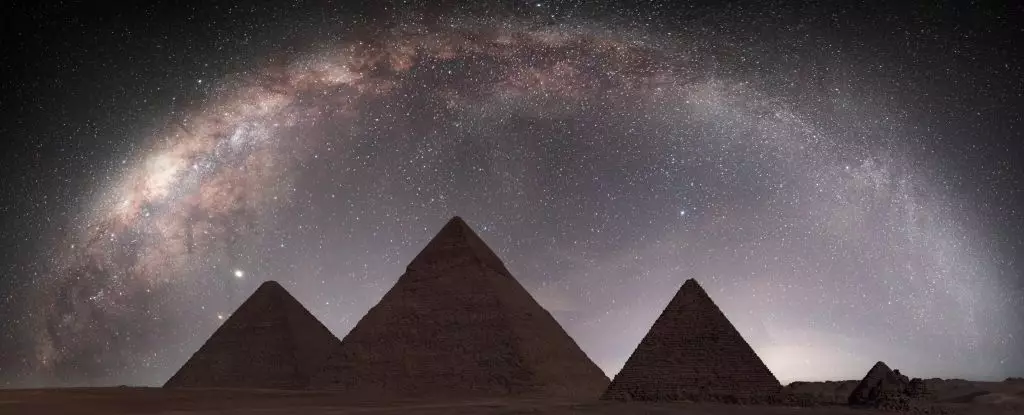For centuries, humanity has gazed upon the vast expanse of the night sky, filled with shimmering stars against a backdrop of darkness. The Milky Way, a breathtaking display of cosmic beauty, has long intrigued thinkers, poets, and artists alike. Now, a groundbreaking study by astrophysicist Or Graur posits that ancient Egyptians might have captured this celestial wonder in their artwork, particularly in the form of Nut, the sky goddess. This connection between ancient mythology and modern astronomy prompts us to reevaluate our understanding of the cosmos as depicted through ancient cultures.
Graur’s examination of hundreds of coffins has sparked a conversation about the profound relationship between art and science. Particularly notable are the representations of Nut—often illustrated as a nude woman adorned with cosmic symbols—who seems to embody the very essence of the sky. However, what makes these depictions most intriguing are the hidden elements that provide insight into humanity’s long-standing fascination with the stars. Graur’s analysis reveals that some interpretations of Nut might contain subtle yet striking visual cues strongly resembling the Milky Way, highlighting a sophisticated cognitive interplay between art, culture, and cosmology in ancient Egypt.
The Artifacts of Cosmic Significance
The investigation led Graur to focus specifically on coffins from the 21st Dynasty, a period ripe with artistic innovation and spiritual exploration. Among his significant findings was the coffin of Nesitaudjatakhet, a singer devoted to the gods Mut and Amun-Re. Her coffin showcased a remarkable portrayal of Nut, with a distinct, flowing line tracing the goddess’s form—intriguingly similar to the Milky Way itself.
This particular design choice cannot be overlooked. Graur suggests that the undulating line could represent not just the Milky Way but the Great Rift, that immense dark band of dust that bisects our galaxy’s luminous band of stars. This observation invites speculation about the extent of the ancient Egyptians’ astronomical knowledge. Were they merely artistic interpretations, or did they possess a deeper understanding of the cosmos? Graur’s assertion that such depictions are rare emphasizes that this was not a universal interpretation but rather an exceptional one that reflects unique perceptions of the universe.
The Significance of Artistic Expression
Analyzing the scant occurrences of similar motifs in Nut’s depictions suggests a carefully thought-out representation rather than a simple coincidence. Although the goddess appears throughout Egyptian funerary art, not every portrayal invokes the Milky Way. The necessity of this distinction is critical: Nut is not merely an emblem of the night sky; she encompasses all celestial phenomena, serving as a guardian of souls navigating the trials of the afterlife. This complexity illustrates the multifaceted nature of Nut, positioning her as a bridge between the divine and the earthly, the cosmic and the human.
Yet, the overarching question remains: what prompted these ancient creators to integrate such intricate celestial motifs into their art? The implication that they might have perceived a deep connection between their goddess and the cosmic realm hints at a sophisticated understanding of reality, interwoven with spirituality. The possibilities are endless when we contemplate how these myths shaped their customs and beliefs, informing everything from funerary practices to their understanding of existence itself.
An Interdisciplinary Approach to Knowledge
Graur’s findings not only open a pathway for integrating art and astrophysics but also highlight the importance of interdisciplinary studies. Ancient Egyptian spirituality is a rich tapestry woven with threads of cultural and scientific inquiry. As modern scholars continue to unravel these complexities, the necessity for digitized museum catalogs – as emphasized by Graur – becomes increasingly clear. Such access would promote collaboration between various disciplines, fostering deeper insights into how history, art, and science interact.
In recognizing the intricate dance between humanity’s spiritual quest and scientific curiosity, we are reminded that knowledge is never truly isolated. Each discovery invites others, encouraging a communal dialogue that transcends time and space. Such is the beauty of exploring the past through multiple lenses; it cultivates a holistic understanding of human nature and our cosmic surroundings.
The ancient Egyptians may have lived thousands of years ago, but their connection to the cosmos through figures like Nut reveals a legacy that persists in our quest for knowledge about the universe today. Thus, the art of ancient civilization continues to resonate, urging us to look beyond mere representations and engage with the profound understanding they offer about our place in the cosmos.


Leave a Reply